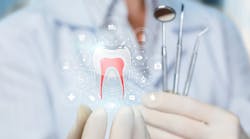Technically speaking: Evidence-based decision-making just went digital (part two)
Editor’s note: This is part two of a series. Read part one here.
Like you, our patients are always looking to be more informed about their treatment recommendations and best practices for oral hygiene care. Most patients turn to the internet for resources regarding their treatment. Sadly, not every source on the internet is a credible option, and some articles blatantly attack the lifesaving work dental professionals do.
I recently read a consumer-facing article that criticized dental professionals and the recommendations we make for our patients. The article asked the reader if they should trust our recommendations, and it said that our “scientific evidence supporting some dental procedures is lacking.”1 The author didn’t reference how we arrive at our decisions and trends in technologies that aid in diagnosis.
Part one of this series: Using technology as a basis for high-quality dental hygiene care
Dental professionals use their expert opinions to make appropriate decisions on current and effective treatments based on evidence of efficacy. Evidence-based dentistry (EBD) has an enormous impact on long-term oral health when used in a preventive/proactive way. Trends in patient education and technology can improve a patient’s understanding of EBD and provide a rationale for our recommendations.
Trends in technology
Radiographs
Far too often, patients don’t accept treatment because they don’t understand what they see. Sixty-five percent of patients admit to not understanding what their provider pointed out on their radiographs, and 55% would like to have a second opinion on radiographic interpretation.2
Utilizing technology to interpret radiographs can have a positive impact on the patient’s perception of dentistry and increase their “dental IQ.” Artificial intelligence software like Overjet and Pearl, when used properly, can improve case acceptance by up to 15%.3 Artificial intelligence is a second opinion.
Scanning
Digital scanning is a great opportunity to share your patients’ current condition using a 3D model. Within moments, a scan can be taken that can aid in detecting malocclusion, interproximal dental decay above the gingiva, inflammation, and arch forms. With the appropriate training, users can identify breathing and airway disorders on the 3D model by evaluating the hard palate and shapes/sizes of each arch. Malocclusion can be identified as well.
Malocclusion can affect periodontal health. Secondary occlusal trauma is a byproduct of malocclusion and contributes to deterioration of the periodontal ligaments, loss of attachment, and ultimately bone loss.4 Proliferation of bacteria, inflammation, and calculus accumulation are results of crowding teeth in some malocclusion cases. With a comprehensive oral evaluation, inclusive of digital scanning, we can arrive at the dental hygiene diagnosis of secondary occlusal trauma and make recommendations to slow or arrest further deterioration of the periodontium. Without thorough evaluation of the patient’s dentition, we may be treating only a small portion of the problem. Utilizing scanning technology is comprehensive in nature and promotes EBD and long-term solutions for optimum oral health.
Who uses technology?
By nature, dental hygienists are inflammation prevention specialists. An inflammation prevention specialist is a health-care provider who focuses efforts on reduction and prevention of oral inflammation. As a specialist whose focus is prevention, we must have thorough and comprehensive assessments that allow us to make recommendations to aid in reducing and preventing further inflammation and deterioration of hard and soft tissues. If patients heed the recommendations made by prevention specialists, there is often little to no need for restorative intervention.
Most patients have a reactive approach to dentistry out of habit or previous experience, and a proactive approach may seem foreign. Using technology offers a new perspective on how to approach oral health. The prevention specialist who integrates technology for assessments and patient education will have more engaged patients who are inclined to make decisions based on prevention of disease.
Ideally, the specialist will use the first 20 minutes of the hygiene appointment to collect data using assessment tools, including technology. The last 40 minutes are used for patient treatment, doctor exam, documentation, and room turnover.
Utilizing technology is a team approach, especially when work conditions are less than ideal. If there are fewer than 60 minutes for an appointment, assessments can still be implemented, but it may take support of other team members. For example, a designated employee can start the assessments on the next patient while the hygienist finishes with the current patient. When the assessments are completed prior to the hygienist entering the room, there’s more time to educate and treat the patient.
How to get dentist buy-in
If your dentist has already made an investment in technology but has not formulated a plan for hygiene department implementation, there is a disconnect in the technology’s role in patient education. It may behoove the prevention specialist to take courses with the dentist and engage in discussion about how this can best work in practice.
Ask the dentist open-ended questions that get their wheels turning:
- “How can you maximize the return on your technology investment?”
- “How do you see technology maximizing your investment in the hygiene department?”
- “When the patient is engaged in the hygiene operatory, what difference do you see in case acceptance?”
These questions can help the dentist to see the value of the prevention specialist and ultimately buy-in to technology being used in the hygiene department as a standard for clinical practice.
How often do you find that you’ve finished a prophy appointment with 15–20 minutes to spare? If you have a full column of prophy patients and you have additional time after the appointment is complete, this may be an opportunity to reevaluate how you assess your patients. Can you use technology to gain case acceptance? If so, I encourage you to consider a systematic approach to implementing technology.
Utilizing voice-activated periodontal charting, using a second monitor to review radiographs enhanced with artificial intelligence and/or the results of periodontal charting, updating intraoral photography, and completing a digital scan are all ways to maximize the time in your hygiene appointment. Not only will you use all the time allotted for the hygiene visit, but you’ll also be fully engaging the patient and increasing value for hygiene services. This can provide the dentist with clear evidence for longer, more comprehensive dental hygiene appointments.
Another way to get the dentist to buy-in to enhanced technologies that support the role of the inflammation prevention specialist is to enhance the hygiene/doctor handoff. Dentists crave information that can be used as fuel to recommend treatment. During the exam, the hygiene handoff is a great opportunity to outline how the assessments relate to risks for deterioration.
The ultimate hygiene handoff should include a professional description of the patient’s chief complaint, an overview of any medical concerns that may contribute or exacerbate dental conditions, an outline of the assessments taken that day, and an explanation of how the assessments relate to a need for intervention. Don’t forget that even if there isn’t a chief concern or need for intervention, the time you spend on the appointment along with your assessments can be used to celebrate the patient’s oral health and improvement.
Where to find continuing education for technology
To practice EBD, one must have evidence! Continuing education courses are a great opportunity to learn more about technology and how it can benefit your patients and practice. Regardless of the technology you choose to implement, the company usually offers on-demand courses and training sessions that can increase your clinical confidence and understanding of how to integrate the software/hardware. Frequently, you can earn continuing education credits for courses associated with technology companies. Even if CE credits aren’t available, the information you learn is invaluable.
There is room for everyone on the team to learn about technology. It’s beneficial to be able to educate patients about the practice protocols and why technology is used. When everyone in the practice is well versed in technological tools, it places value on workflows that support seamless integration.
Editor's note: This article appeared in the March 2023 print edition of RDH magazine. Dental hygienists in North America are eligible for a complimentary print subscription. Sign up here.
References
- Roberts C. Read this before your next trip to the dentist. Consumer Reports. August 4, 2022. Updated August 9, 2022. https://www.consumerreports.org/dental-oral-care/read-this-before-your-next-trip-to-the-dentist-a5054427914/
- Open wide: how AI is Reshaping the future of dentistry. Pearl. https://cdn2.hubspot.net/hubfs/5664760/OpenWide_Pearl_Book_Final_2.pdf
- Balaban CM, Gibree SA, Athar A, et al. AI-driven growth of DSOs. Compend Contin Educ Dent. 2021;42(3):e5-e9.
- Fan J, Caton JG. Occlusal trauma and excessive occlusal forces: narrative review, case definitions, and diagnostic considerations. J Periodontol. 2018;89(Suppl 1):S214-S222. doi:10.1002/JPER.16-0581







